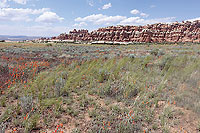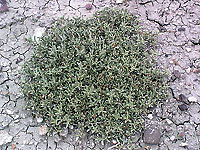As climate change causes more frequent and severe drought on the Colorado Plateau, an important question facing ranchers, land managers, and scientists is: how does drought affect native plant communities? To anyone who has ever forgotten to water their house plants, the answer may seem obvious – too little water is bad for plants! But plants can grow in incredibly dry places – take the iconic saguaro cacti of Arizona, or the odd Welwitscia plant of the Nambian desert, which lives for hundreds of years in a region that receives less than half the yearly rainfall of Moab. So the effects of drought on areas with diverse plant species may be less predictable than they seem at first glance.
 |
| Spring brings orange globemallow flowers and bright green needle-and-thread grass to Chesler Park. Globemallow and needle-and-thread plants use C3 photosynthesis, so they grow best in the spring and fall. |
Different plant species have a variety of adaptations to survive and thrive in low water conditions. We can easily observe some of these adaptations, such as cacti storing moisture in thick stems and leaves. However, one adaptation to dry conditions that plays an important role on Colorado Plateau rangelands is invisible to the naked eye! This adaptation involves a subtle but critical change to the process of photosynthesis.
Most plants use the same set of chemical reactions to capture energy from sunlight, a process known as C3 photosynthesis. This process requires a high concentration of carbon dioxide inside the plant’s leaves. Leaves have tiny pores that open to allow carbon dioxide in, but they also let a lot of moisture out, especially when it is hot. In hot, dry weather, plants using C3 photosynthesis close their leaf pores to prevent water loss, but this blocks carbon dioxide from entering the leaves and slows down energy storage. Because plants that use C3 photosynthesis grow best under cooler conditions, scientists call them “cool season” plants. Cool season plants on the Colorado Plateau include Indian ricegrass, needle-and-thread grass, and many others. If a plant grows best in the spring, it is probably using C3 photosynthesis.
Some plants use a slightly different processes, called C4 photosynthesis, that allows them to absorb energy from the sun with less carbon dioxide inside their leaves. Because these plants need less carbon dioxide in their leaves, they can partially close their leaf pores to reduce water loss while continuing to store up energy. Being able to retain water while still harvesting energy from the sun is a great strategy for hot, dry conditions! However, in cool weather, this process is less efficient than C3 photosynthesis, so scientists call plants that use C4 photosynthesis “warm season” plants. Galleta grass and blue grama are some warm season plants of the Colorado Plateau. These grasses stay green throughout the hot summer months, relying on the summer monsoon storms to support their growth.
 |
| Mat saltbush uses C4 photosynthesis to thrive during the summer monsoon season. |
The difference between cool season and warm season plants may seem small—microscopic, in fact—but it helps determine which plants grow best from season to season and year to year. During low snow years, cool season plants suffer, while low monsoon rainfall hurts warm season plants more.
And the situation gets even more complex! Different root and leaf structures and soil types also affect which plants survive droughts. Additionally, climate change models predict more variable precipitation on the Colorado Plateau, so while droughts will become more common, so may unusually wet years.
Current research projects by the National Park Service, the US Geologic Survey, and others aim to understand which plant species will suffer under climate change conditions and which will thrive. It’s a challenging question to study, but finding answers is important for the health of Colorado Plateau ecosystems!
|